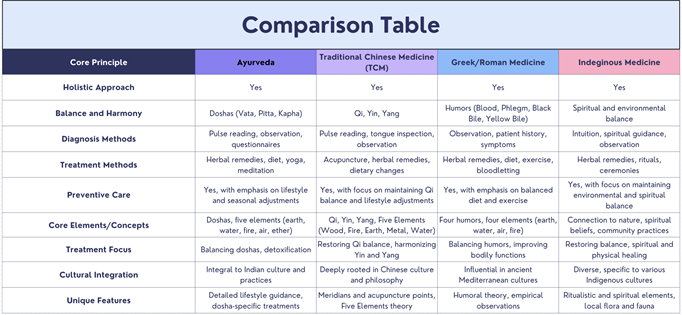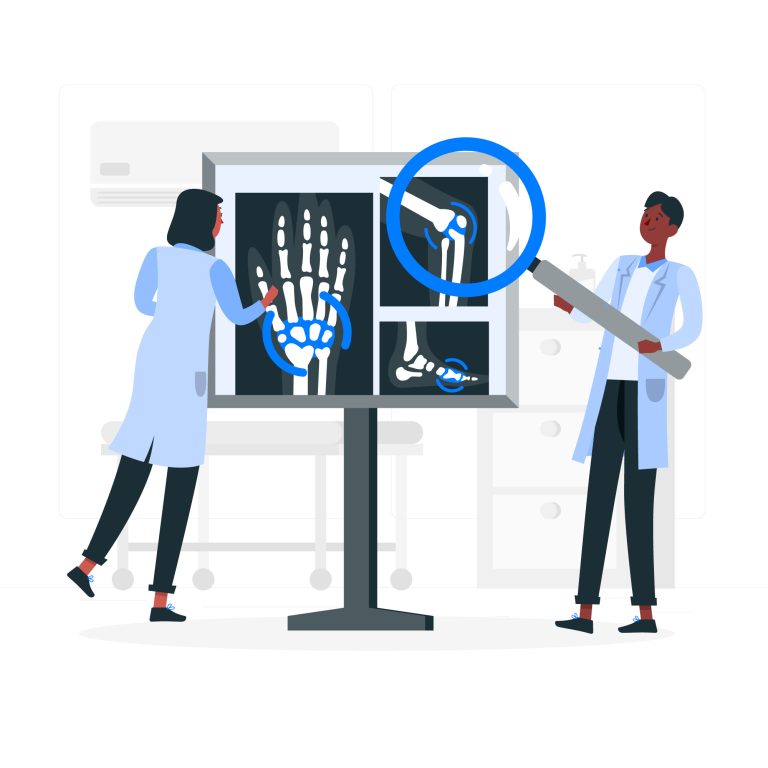The Foundation of Ancient Health Systems
Home remedies have been passed down generationally, but where did they start? It is important to understand the origins of this household knowledge, which stems from ancient healthcare systems. Practices and beliefs from Ayurveda, Traditional Chinese Medicine, Greek and Roman medicine, and Indigenous traditions still influence today’s Western-oriented healthcare. Despite the dilution of this knowledge in the modern industry, our homes continue to preserve these practices. These ancient systems hold household value, even as they slowly come back into the broader healthcare system.

Ayurveda
Ayurveda is an ancient Indian system of medicine centred on balancing the three doshas—Vata, Pitta, and Kapha—derived from the five elements (earth, water, fire, air, and ether). These doshas govern various bodily functions and must be harmonious to maintain health. Ayurveda emphasizes understanding an individual’s Prakriti (inherent constitution) and Vikriti (current imbalance) to tailor treatments. It also highlights the importance of Agni (digestive fire) for nutrient absorption and the role of Ojas (vital essence) in immunity. The system advocates for a balanced diet (Ahara) and lifestyle (Vihara) to support overall well-being, incorporating a holistic approach that integrates physical, mental, and spiritual health. Ayurveda embraces a holistic approach, integrating body, mind, and spirit. For instance, Turmeric Milk, known as “Golden Milk,” is more than just a drink; it reduces inflammation and promotes digestive health, reflecting the principle of balancing internal energies. Similarly, Ginger Tea is a remedy that aids digestion and alleviates nausea, while Ashwagandha, an adaptogenic herb, helps manage stress and boost vitality. These remedies underscore Ayurveda’s core principle of achieving harmony and balance through natural means.
Traditional Chinese medicine
Traditional Chinese Medicine (TCM) is an ancient health system grounded in the holistic view that balance among the body’s vital energy (Qi), Yin and Yang, and the Five Elements (Wood, Fire, Earth, Metal, Water) is essential for well-being. TCM emphasizes that Qi, the vital life force, must flow smoothly and balance for optimal health. Yin and Yang represent opposing but complementary forces; health is achieved when these forces are in harmony. The Five Elements correspond to various bodily and emotional functions and interact dynamically to influence health. Additionally, TCM uses a network of meridians (energy channels) and specific acupuncture points to regulate Qi flow and restore balance. Generational household remedies such as ginger tea for colds, Ba Zhen Tang herbal soup for energy, goji berries for immunity, licorice root for respiratory issues, and jujube dates for improving sleep reflect the practical application of these principles, showcasing TCM’s deep-rooted influence on daily health practices.
Greek & Roman Medicine
Greek and Roman medicine centred on several core principles that shaped their holistic approach to health. The humoral theory, introduced by Hippocrates and later developed by Galen, posited that health depended on balancing four bodily fluids—blood, phlegm, black bile, and yellow bile. An imbalance in these humors was believed to cause disease. Naturalism played a key role, with physicians understanding the body as a microcosm of the natural world, where environmental factors such as air, water, and diet were integral to health. Empirical observation was emphasized, with a scientific approach to documenting symptoms and treatments to develop effective medical practices. The principle of balance and moderation applied to the four bodily humours and the overall lifestyle. Physicians believed that health depended on the balance of these humors—blood, phlegm, black bile, and yellow bile. An imbalance among them was thought to cause illness. The diagnosis was based on identifying symptoms of these imbalances and treatments aimed to restore equilibrium through diet, exercise, and rest. This holistic approach extended to lifestyle practices, advocating for a balanced diet, regular exercise, and adequate rest to harmonize physical, mental, and environmental factors, thereby maintaining health and preventing disease.
Indigenous Practices
Indigenous medical practices are deeply rooted in a holistic approach that integrates physical, spiritual, and environmental dimensions of health. Central to these practices is the belief that well-being is achieved through a balance of body, mind, and spirit, with disruptions affecting overall health. Connection to nature is fundamental, as Indigenous systems emphasize using local plants, animals, and minerals, reflecting a deep respect for the interconnectedness of all life. Spirituality plays a crucial role, with healing often involving rituals, prayers, and ceremonies to restore balance and address health issues. Community and tradition are essential, with knowledge passed down through generations and elders or traditional healers guiding practices. Maintaining personal and environmental balance is also essential, as well as promoting mindful living and sustainable use of resources. Generational household remedies exemplify this approach: Echinacea is used for immune support and wound healing, sweetgrass is burned for purification and positive energy, yarrow is applied for wounds and fever, willow bark provides pain relief similar to aspirin, and bear root addresses digestive issues and infections. These practices highlight the Indigenous belief in the profound connection between health, nature, and spirituality.
In conclusion
Ayurveda, Traditional Chinese Medicine (TCM), Greek and Roman medicine, and Indigenous practices all share a holistic approach to health, emphasizing physical, mental, and environmental integration. They focus on achieving balance and harmony within the body and its surroundings—Ayurveda through the doshas, TCM through Qi, Yin, and Yang, Greek and Roman medicine through the humors, and Indigenous practices through spiritual and environmental balance. All systems also value natural remedies and preventive care, incorporating lifestyle and environmental factors into their health paradigms. They utilize traditional knowledge passed down through generations and often involve community-centred approaches to healing, recognizing the interconnectedness of individuals with their broader environment. These similarities underscore a shared understanding of health as a dynamic balance between internal and external influences.
Key Highlights:
- Holistic Approach: All systems emphasize a holistic view of health, integrating physical, mental, and environmental factors.
- Balance and Harmony: Each system has a unique framework for achieving balance (doshas in Ayurveda, Qi in TCM, humour in Greek/Roman medicine, and spiritual/environmental balance in Indigenous practices).
- Diagnosis Methods: Diagnostic methods vary but generally include observation, patient history, and specific techniques (pulse reading, tongue inspection, etc.).
- Treatment Methods: Treatments often involve natural remedies and lifestyle modifications but differ in techniques (e.g., acupuncture in TCM and yoga in Ayurveda).
- Preventive Care: Though the specifics vary, all systems advocate for preventive measures.
- Cultural Integration: Each system is deeply integrated into its respective culture and has unique practices reflective of its cultural context.
- Unique Features: Distinct elements, such as dosha-specific treatments, acupuncture points, or ceremonial practices, highlight each system’s uniqueness.
References
Lad, V. (2002). The Complete Book of Ayurvedic Home Remedies. Harmony Books.This book provides an in-depth look at Ayurvedic principles, including the doshas, Prakriti, Vikriti, Agni, and Ojas, and offers practical home remedies.
Frawley, D. (2000). Ayurveda and the Mind: The Healing of Consciousness. Lotus Press. Frawley’s work explores Ayurvedic concepts related to the mind, Agni, and the holistic nature of Ayurveda, including its impact on mental and emotional health.
Sahni, S. (2007). Fundamentals of Ayurveda: A Comprehensive Guide to Traditional Indian Medicine for the Modern Practitioner. Keats Publishing.This guide covers the foundational aspects of Ayurveda, including the doshas, elements, dhatus, and the role of diet and lifestyle.
Maciocia, G. (2005). The Foundations of Chinese Medicine: A Comprehensive Text for Acupuncturists and Herbalists. Elsevier.While primarily focused on Chinese medicine, this text provides comparative insights into holistic principles relevant to Ayurveda.
Sharma, H., & Clark, C. (2006). Principles of Ayurveda. Elsevier.This resource offers a detailed exploration of Ayurvedic principles, including doshas, dhatus, and the importance of balance in health.
Kaptchuk, T. J. (2000). The Web That Has No Weaver: Understanding Chinese Medicine. This book provides a comprehensive introduction to TCM’s principles and practices.
Chen, K., & Chen, L. (2014). Traditional Chinese Medicine: A Holistic Approach to Health and Healing. This text explores the foundational concepts of TCM and their application in modern contexts.
Xu, J., & Yu, W. (2017). Herbal Medicine in China: An Overview of Traditional Use and Research. This book includes information on traditional remedies and their uses across generations.
Hippocrates. (c. 400 BCE). The Hippocratic Corpus. A collection of texts attributed to Hippocrates that outlines early Greek medical practices and principles.
Galen. (2nd century CE). On the Natural Faculties. Galen’s extensive writings on anatomy and medicine reflect the Roman understanding of humoral theory and holistic health.
Nutton, V. (2004). Ancient Medicine. This book provides an in-depth analysis of Greek and Roman medical theories and practices.
Longrigg, J. (1993). Greek Medicine: From the Heroic to the Hellenistic Period. This work explores the evolution of Greek medical practices and their holistic approach.
Aguirre, R. (2015). Traditional Ecological Knowledge: Indigenous Perspectives on Nature and Health. This book explores the holistic and environmental aspects of Indigenous health practices.
Cox, P. A., & Balick, M. J. (1994). The Ethnobotany of Indigenous Peoples: Applications and Implications. This text provides insights into traditional remedies and the principles underlying Indigenous medical systems.
Kuhnlein, H. V., & Receveur, O. (1996). Indigenous Peoples and Traditional Foods. This work highlights the connection between traditional foods, health practices, and cultural identity.




